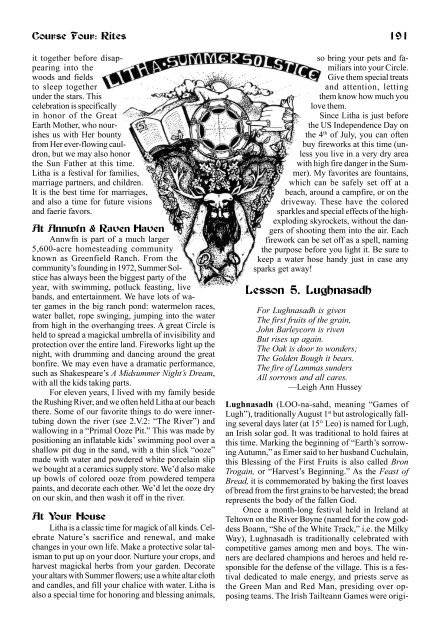Grimoire for the Apprentice Wizard
Create successful ePaper yourself
Turn your PDF publications into a flip-book with our unique Google optimized e-Paper software.
190<br />
be lit using spark from<br />
flint and steel. In ancient<br />
times, great fires<br />
were lit upon hilltops<br />
to signify <strong>the</strong> coming of<br />
Spring and to pray <strong>for</strong> an<br />
abundant Summer. Walpurgisnacht<br />
is traditionally<br />
regarded as a night of madness,<br />
when <strong>the</strong> veil between<br />
<strong>the</strong> worlds is particularly thin;<br />
it is <strong>the</strong> opposite hinge of <strong>the</strong><br />
year from Samhain, and <strong>the</strong> beginning<br />
of <strong>the</strong> Summer half of <strong>the</strong><br />
year. In classical times May Eve was<br />
<strong>the</strong> Festival of Hades, Lord of <strong>the</strong><br />
Underworld.<br />
At Annwfn<br />
At Annwfn we hold an all-night ritual<br />
and Bardic on Walpurgisnacht, generally<br />
with a <strong>the</strong>me involving a journey into <strong>the</strong><br />
mythic realm, or Faerie. We hold bawdy May<br />
games to select <strong>the</strong> Queen and King of <strong>the</strong><br />
May, who are crowned as Hornéd Man (Robin)<br />
and Flower Maid (Marion), and who represent <strong>the</strong> men<br />
and women of our community during <strong>the</strong>ir reign (until<br />
Samhain <strong>for</strong> <strong>the</strong> King; a full year <strong>for</strong> <strong>the</strong> Queen).<br />
Children’s May Games are also held to select a May<br />
Princess and Prince, and <strong>the</strong> new Royal Court will convene<br />
at festivals throughout <strong>the</strong> Summer season. During<br />
<strong>the</strong> year, <strong>the</strong>y visit <strong>the</strong> homes of <strong>the</strong> people, bringing<br />
blessings into each.<br />
The maypole dance is, of course, <strong>the</strong> centerpiece<br />
of Beltaine, and <strong>the</strong> women prepare <strong>the</strong> Maypole<br />
crown, <strong>the</strong> Circle, <strong>the</strong> Gate, and <strong>the</strong> hole, decorating<br />
<strong>the</strong>m with ribbons and flowers, while <strong>the</strong> men go off to<br />
bring in <strong>the</strong> huge 20’ maypole. The pole is carried in<br />
procession on <strong>the</strong> shoulders of <strong>the</strong> men, led by <strong>the</strong><br />
King. It is brought through <strong>the</strong> Gate with great merriment,<br />
crowned, placed in <strong>the</strong> hole, and raised (it’s anchored<br />
with rocks). Everyone grabs an end of <strong>the</strong> many<br />
long ribbons hanging from <strong>the</strong> crown, and we dance<br />
<strong>the</strong> weaving dance to wrap <strong>the</strong> pole and <strong>the</strong> King while<br />
pipers and drummers play a lively beat. The Maypole<br />
Rite is <strong>the</strong> Sacred Marriage of <strong>the</strong> new Queen and<br />
King, and he is bound to <strong>the</strong> pole while she dances<br />
around him.<br />
At Your House<br />
Beltaine is a time of courtship, and if <strong>the</strong>re is someone<br />
you especially like (including your mo<strong>the</strong>r), this is<br />
a perfect occasion to give him or her a May basket full<br />
of fresh-picked flowers. Decorate your altar with Spring<br />
flowers and colorful ribbons; use a dark green altar<br />
cloth and candles. Make and wear floral wreaths. This<br />
is <strong>the</strong> festival of regeneration of <strong>the</strong> Earth. Express<br />
<strong>Grimoire</strong> <strong>for</strong> <strong>the</strong> <strong>Apprentice</strong> <strong>Wizard</strong><br />
love and care to those<br />
close to you; feed each<br />
o<strong>the</strong>r in a special ritual<br />
meal. You might even<br />
crown a May Queen and<br />
King.<br />
If you have room in your<br />
backyard, you can put up<br />
a maypole—at least 10’ tall!<br />
Ribbons should be about 1 1/<br />
2 times as long as <strong>the</strong> pole and<br />
fastened to <strong>the</strong> top be<strong>for</strong>e <strong>the</strong><br />
pole goes up. There must be an<br />
even number, and it’s best to have<br />
<strong>the</strong>m in just two colors: red and<br />
green (or red and white). There has<br />
to be one dancer <strong>for</strong> each ribbon, so<br />
if you only have four people, just use<br />
four ribbons. People alternate ribbon colors,<br />
facing opposite ways: Red turns to<br />
<strong>the</strong> left, moving deosil (clockwise), and<br />
green to <strong>the</strong> right, moving widdershins<br />
(counter-clockwise).<br />
You dance <strong>the</strong> circle by alternately moving<br />
outside and <strong>the</strong>n inside of <strong>the</strong> people coming<br />
towards you, weaving <strong>the</strong> ribbons over and <strong>the</strong>n<br />
under <strong>the</strong>irs in turn. Finally, when <strong>the</strong> woven ribbons<br />
get too low on <strong>the</strong> pole to keep dancing, all <strong>the</strong> dancers<br />
run deosil to wrap <strong>the</strong> remainder around and tie<br />
<strong>the</strong>m off as a spell <strong>for</strong> prosperity and growth in <strong>the</strong><br />
coming year. Afterwards, when you take down <strong>the</strong><br />
pole, you will find that <strong>the</strong> woven tube of ribbons can<br />
be slipped off <strong>the</strong> pole like a stocking, and saved as a<br />
special charm <strong>for</strong> lovers. It makes a great wedding gift!<br />
Lesson 4. Litha<br />
When day is at its longest,<br />
Folk, fields and flocks all thrive;<br />
The sunlight at its strongest<br />
Feeds everything alive.<br />
The stately Birch, most splendid,<br />
Brings all good things within.<br />
The Summer fire is tended<br />
To be <strong>the</strong> bright sun’s twin.<br />
—Leigh Ann Hussey<br />
Litha (LITH-ah), also called Midsummer, is <strong>the</strong> Summer<br />
Solstice, about June 21. Litha is <strong>the</strong> name of a<br />
Saxon grain goddess, cognate with Demeter or Ceres,<br />
and Her festival is one of joy, abundance, and play. It<br />
was Christianized as St. John’s Day. On this longest<br />
day of <strong>the</strong> year, picnicking, swimming, and water play<br />
are customary, as are bonfires and fireworks in <strong>the</strong><br />
evening.<br />
Throughout Europe, lovers clasp hands or toss<br />
flowers to each o<strong>the</strong>r across <strong>the</strong> bonfire, or leap through



